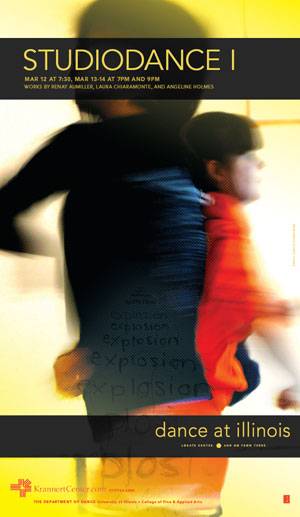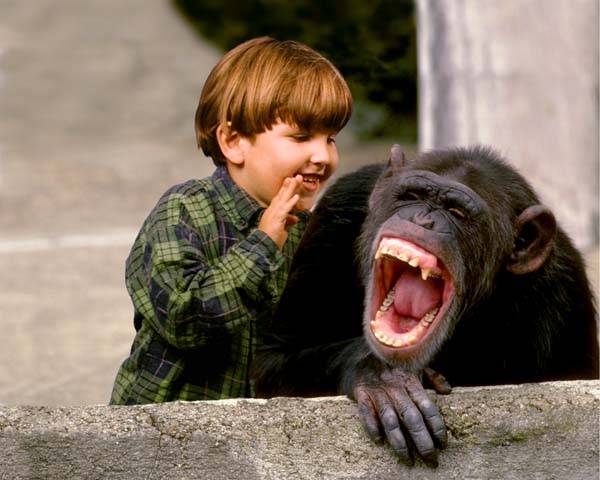 You’ll laugh. You’ll smile. You’ll … drift in and out of consciousness?
You’ll laugh. You’ll smile. You’ll … drift in and out of consciousness?
You can expect to do all of these things and more at Dance at Illinois’ Studiodance I Concert.
Studiodance I is composed of thesis works by graduating Dance MFA candidates Renay Aumiller, Laura Chiaramonte, and Angeline Holmes. The MFA students each had 20 minutes at their disposal; how this time was allotted between solos and group pieces was up to them. The concert challenges social perceptions of humor, imbues happiness in grand fashion, and explores the realm of the unconscious, all in under an hour.
Angeline Holmes kicks off the concert by amping up the room’s energy.
Holmes greatly enjoyed her role in a production of High School Musical last summer and wanted to share her experience with the world. Her thesis, Like It, Love It, Gotta Have It, features songs from the musical, such as “The Start of Something New” and “We’re All in This Together,” alongside many other “feel good” tracks. She says that she is exploring Noel Coward’s dictum, “never underestimate the potency of cheap music.”
Holmes loves working with large groups. In Like It, Love It, Gotta Have It, a cast of thirty-seven works together to take the audience on a fun-filled journey through music and dance. The happiness and excitement that Holmes creates can only be described as contagious. Without a doubt, she will have you smiling by the end of her piece.
Shift, a piece choreographed by Laura Chiaramonte, uses metaphor, imagination, memory, and dream to explore shifting degrees of human consciousness. In her research, Chiaramonte was intrigued by the theories of psychiatrist Carl Jung, who believed that the human psyche is religious by nature. She studied the I-Ching, one of the oldest of the Chinese classic texts. The book illustrates a symbol system that is used to identify order in random events. It allows for changes of perception, which gives people a connection to the inner forces that may or may not be influencing their lives.
“Using a divinatory system is an exploration of the unconscious side of a situation,” Chiaramonte says. “The answers are not so black or white.”
Composer Ben Smith and vocalist Megan Smith provide live music for Shift, creating a tranquil, fluid ambiance. Chiaramonte’s work features moments of what seems to be self-deprecation while the choreography is performed at a slow pace.
“The amazing thing that dance can do is … it can induce something in the mind both as the observer and as the performer to create these states of consciousness in the present moment. It’s more about observing what is going on and being a part of it than an actual performance in itself,” Chiaramonte says.
Renay Aumiller’s thesis, Junk, opens with the image of dancers being birthed from garbage bags. A metaphor for the highly disposable life of a dancer, Junk tackles themes relevant to the performance lifestyle. One dancer speaks out against lack of recognition while another soaks up the spotlight. The piece also tackles the controversial role of nudity in art.
“There is nudity … but it’s done in a way to separate the naked body from sexual connotations and/or residue. The nudity is used as a comment on trends in contemporary dance today and the things we are asked to do on a regular basis,” Aumiller says.
 Aumiller focused her graduate research on discovering why people laugh, which led her to three different humor theories: the Superiority Theory, Relief Theory, and Incongruity Theory. The Superiority theory states that a person laughs about the misfortunes and shortcomings of others because they assert feelings of superiority. The Relief Theory explains laughter as a release of nervous energy. For example, people may laugh while attending a funeral. The Incongruity Theory states that laughter is produced as a reaction to the appearance of unexpected, incongruous concepts in a given situation. Aumiller used these theories to inform her space and time structures in the choreography.
Aumiller focused her graduate research on discovering why people laugh, which led her to three different humor theories: the Superiority Theory, Relief Theory, and Incongruity Theory. The Superiority theory states that a person laughs about the misfortunes and shortcomings of others because they assert feelings of superiority. The Relief Theory explains laughter as a release of nervous energy. For example, people may laugh while attending a funeral. The Incongruity Theory states that laughter is produced as a reaction to the appearance of unexpected, incongruous concepts in a given situation. Aumiller used these theories to inform her space and time structures in the choreography.
“I manipulate the timing of movement to produce super-slow movements that appear highly exaggerated and ridiculous. I then set it next to a highly physical movement phrase that is sped up and violent,” she says.
Jarring juxtaposition exists within and between theses, creating a concert that is sure to resonate both cognitively and emotionally with its viewers. If you want to mix up your theater experience, this is the show for you.
Studiodance I runs March 12–14 at the Krannert Center for the Performing Arts.








